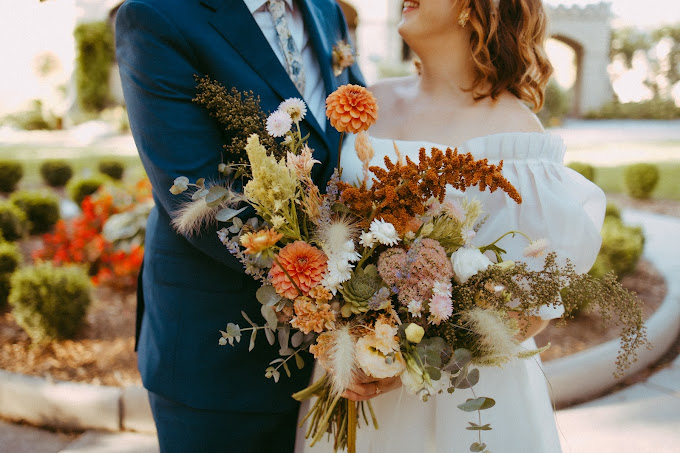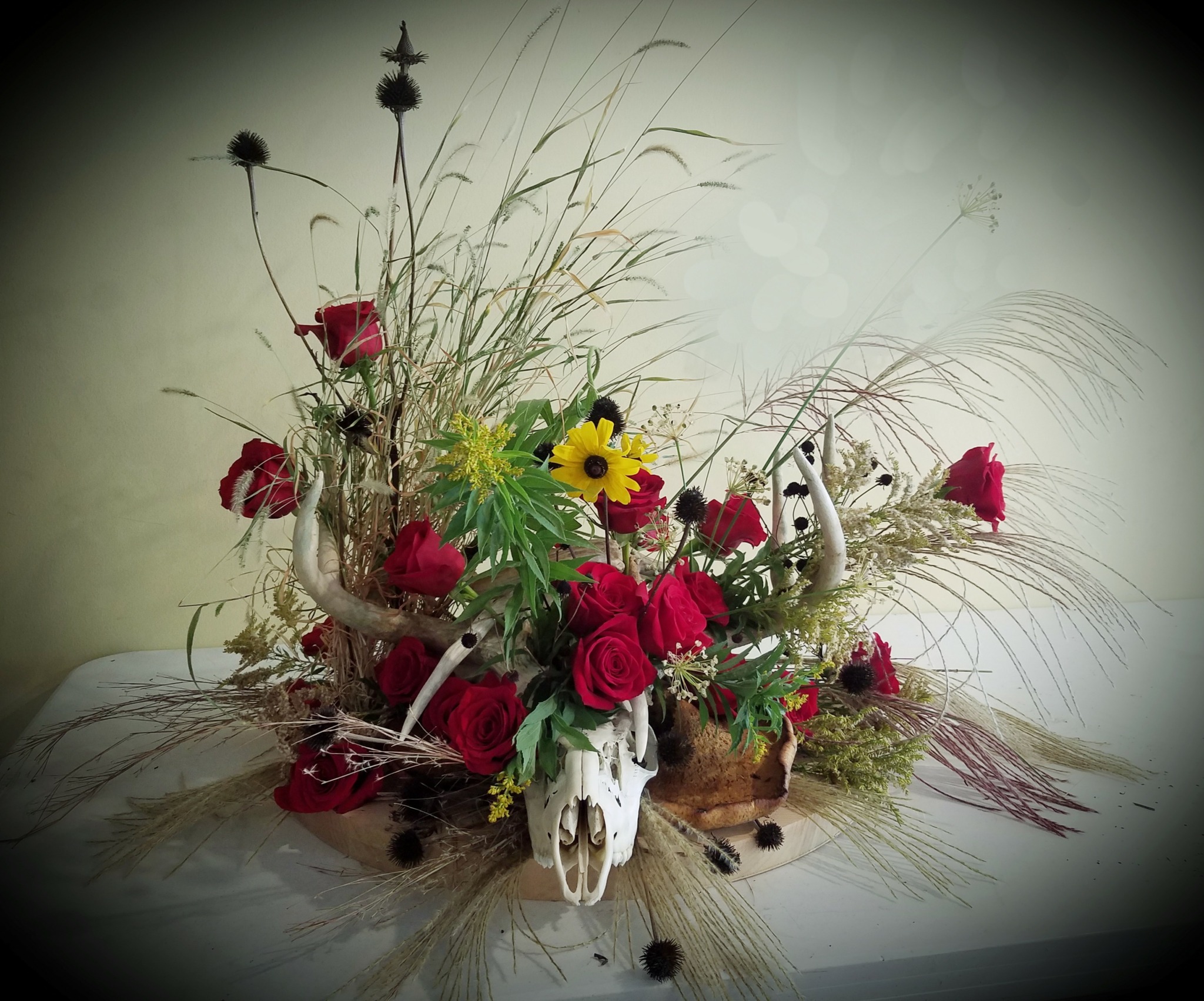We caught up with the brilliant and insightful Holly Lukasiewicz a few weeks ago and have shared our conversation below.
Holly, thanks for taking the time to share your stories with us today Let’s start with the story of your mission. What should we know?
With a background as a public school art educator, I found myself yearning for opportunities that offered meaningful intersection for my identities as an artist, an educator and an environmentalist. Mid-pandemic I made a career pivot to pursue floral design.
Now I see the Earth as the ultimate provider for my art materials – perennial and annual plants and grasses – I am grateful for the interconnectedness of my community’s ecosystem, sourcing locally and using seasonal plants from urban farms, specialty-cut flower farms, and even my own garden. During our midwest dormancy season I source American-grown flowers from a flower wholesaler.
Seasons dictate my supplies. As an act of reciprocity, my intent is to let the season lead. Floral design as a creative practice offers a unique opportunity to explore ephemerality daily. Knowing a florist’s supplies come directly from our Earth – water and flora – an ecologically-sensitive design practice guides my creative choices by weighing their impacts on environmental ecosystems.
In many ways, flowers are my activism. Their intersection with justice, equity, economics, and environmentalism has helped me understand their interconnectedness. For that, I am grateful to them. They’ve helped me recognize that social and environmental justice are intertwined.
The movement toward intersectional environmentalism focuses on achieving climate justice, amplifying historically excluded voices, and approaching environmental education with equity, inclusion, and restorative justice in mind. To understand the scope of intersectional environmentalism in the context of an ecologically-sensitive design practice, I think about how I source flowers, choosing to pass on the use of artificially bleached botanicals, painted and dyed botanicals, and floral foam.
I share these tangible shifts I’ve made within my own practice to center my reciprocal relationship with Nature, my dependency on her, and my connectedness to her. I share this with the hope that others examine their consumptive habits and consider the unseen ecological impacts of one’s choices. My hope is that more businesses become transparent in disclosing the ethics of their production practices.


Holly, before we move on to more of these sorts of questions, can you take some time to bring our readers up to speed on you and what you do?
District 2 Floral Studio is my creative practice allowing me to merge my identities as an art educator and environmentalist by creating flora-based works inspired by the ephemerality each season offers. I am deeply grounded in local agriculture and sustainable design practices as they relate to the well being of our local and global communities.
Encouraging others to connect with sustainability through beauty and flowers, I offer workshops, flower subscriptions, event work, custom installations, New Moon monthly subscriptions, and pressed flower design services.
Why Sustainability? Being gentle with our Earth means understanding the impact of our consumption on various systems and issues. Supporting sustainable environmental, social, and economic practices makes sense for climate resiliency. I source flowers from local farmers and from American/domestic farmers during dormant seasons. This approach:
-Reduces the carbon footprint of transporting flowers.
-Ensures safe and fair working conditions for those involved in the production process.
-Supports the financial stability of local growers who practice more regenerative farming.
The Slow Flower Movement, much like the Slow Food Movement, aims to connect us with our local seasons and their unique abundance. To minimize waste, I use pre-loved vessels and avoid single-use plastics (such as floral foam/Oasis, plastic picks, and synthetic ribbon), as well as synthetically bleached, dyed, or painted flora. Excess stem and foliage trimmings are composted through a local commercial compost facility, Hillside Solutions, to support local circular farming systems.
Due to the nature of the work as District 2 Floral Studio – working with natural elements that are gifted to us from the Earth – this year I established a social impact giving partnership so that a portion of District 2 Floral Studio sales are shared as a voluntary land tax with the Honor Native Land Fund (HNLF).
The HNLF is a voluntary land tax opportunity for non-Native people living in the Midwest – particularly the homelands of the Ho-Chunk, Winnebago, Ioway, Meskwaki, Fox, Sauk, Dakota, and other nations – to contribute to Native efforts to restore land and water to Indigenous stewardship.


Is there a particular goal or mission driving your creative journey?
As a flower design studio whose practices are rooted in sustainability through beauty and flowers, my relationship with flora is inspired by the Slow Flowers Movement. Similar to the Slow Food Movement – which formed in response to fast food chains and a growing disconnect between where our food comes from, who grows it, how it is prepared, and the decline of eating meals with others – the Slow Flowers Movement came from the writing of Debra Prinzing and is a response to the past 30 years of United States policy changes that created an influx of dependency upon foreign-grown flowers. It is a movement towards knowing where your flowers are grown, your farmer’s name, the ethical conditions of the workers, and types of chemicals used (if any).
Domestically-grown, especially locally-grown cut flowers, require far fewer resources to get crops from Point A (the farm) to Point B (designer), fewer, if any, chemicals to preserve flowers during transport, shorter transport times, less fossil fuel, less packaging, less single-use plastic. When sourcing locally through our local flower market, Flatland Floral Collective, I also get to know farmers by name and understand how much they care about their farming practices and witness the depth of their knowledge on cultivating flowers in the extreme conditions the midwest offers.
As part of the Slow Flowers Society, I am transparent with my clients about where flora are sourced. Sometimes this means certain flora we’ve grown accustomed to seeing for specific seasons and/or holidays just aren’t available. I hope that kind of transparency brings into focus a more complete picture of how sourcing from local specialty-cut flower farmers connects to safeguarding the health of our ecosystems and building economic justice.


Are there any books, videos or other content that you feel have meaningfully impacted your thinking?
I’m guided by the wisdom and writings of Indigenous botanist, Robin Wall Kimmerer. Her book “Braiding Sweetgrass” had a profound impact on how I view my relationship with the natural world and a better understanding of how reciprocity enters my work.
My practice is free from the use of foam as a structural element, free from the use of single-use plastic items (such as card picks and flower wraps), free from the use of bleach, synthetic dyes, or paints. I compost unused foliage and stems. I use natural fiber ties that are compostable. I source vessels from resale shops to lessen waste consumption. I source as locally as possible with the seasons, and from local farmers and other land stewards. I research sustainable approaches to floral design, and take classes online that offer instruction in foam and plastic-free alternatives.
Second, the writings of Cèline Semaan whose essay on the design concept of valuing “ecosystems over aesthetics” guided me to make design choices rooted in reducing environmental harm while promoting social equity. I no longer make design choices based solely on trend-worthy aesthetics that often come at the price of ignoring the harm created in the process to workers and environmental ecosystems. Cultivating an ecologically-sensitive design practice grounded in intersectional environmentalism has helped me understand the larger perceptual shifts that accompany small gestures of reciprocity.
They’ve helped me connect with mentors whose knowledge and generosity continue to shape my practice.
Contact Info:
- Website: https://District2Floral.com
- Instagram: https://www.instagram.com/district2floral/profilecard/?igsh=Y2pxOHg1MzI4ZXZ6
- Facebook: https://www.facebook.com/district2floral?mibextid=ZbWKwL
- Other: Pinterest: https://www.pinterest.com/District2FloralStudio/


Image Credits
1. Holly holding flower bucket: Photo by Meg Sperry Photography
2. Upclose of wedding bouquet held by bride: Photo by Jesi Lee Photography
3. Purple floral headpiece: Photo by Crystal Lily Creative
4. Upclose of floral garland arbor installation: Photo by M. Julie Photography


